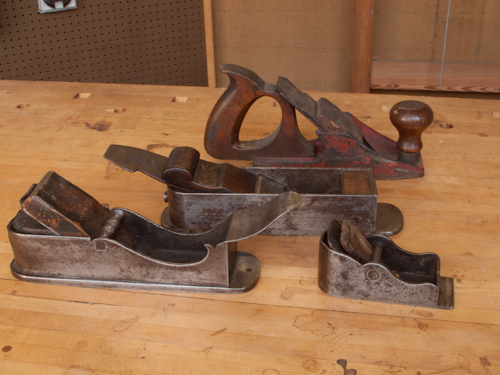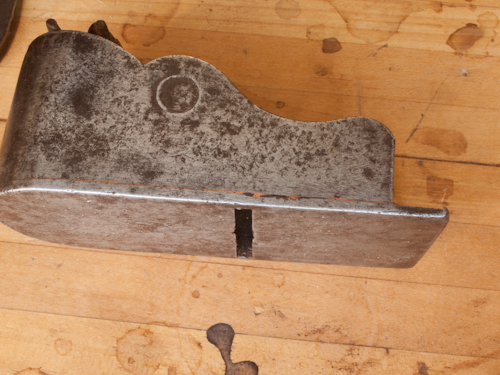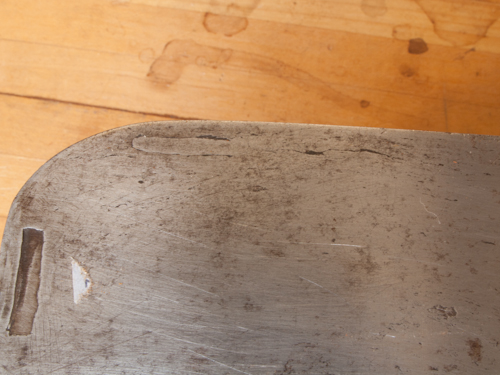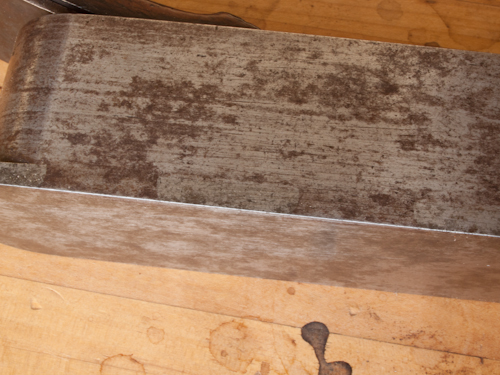|
|
09/13/2011 |

One of the primary ways of dating an early iron plane is by the way it's built.
Early European iron planes were made by brazing or silver soldering the metal parts together. Unlike today, the Renaissance artisan didn't have a blowtorch so brazing was done by placing the entire object, fluxed and bound together in a furnace and heating the entire object up until the solder melted. Multiple applications of solder were possible by using carefully graded solders that melted at successfully lower temperatures. in the detailed photos of the oldest plane in the group photo, the small smoother in the right foreground, you can see the evidence of the brazing of the wrought iron sides to the sole.

Later, larger iron planes, like the one in the left foreground, a mitre plane probably from the mid-18th century used tapered square mortises and tenons forged into the metalwork and then spread together. This type of joint gives a mechanical connection and doesn't require the heat needed for brazing a large object. It's still tricky to do, and requires skill at the forge. In the next closeup we can see one of the mortises that were used to attach the sides. The joints are long and not so straight and evidence of the forging of the joint. The rear mortise has partially pulled out do to repeated hammerings at the back of the plane in use.

By moving the mortise to the edge of the sole, a side opens up and you save yourself the hassle of having to drill though the sole. By using a double taper, top to bottom like a dovetail and also forming a wedge into the side to make a double dovetail you can forge the metal into the side of the sole and get a joint that when done well is nearly invisible, and will never get loose. While impossible for woodworkers spreading the dovetail in both dimensions rivets everything together permanently. The late 18th or early 19th century mitre plane shown in the picture (middle) is made like this and you can just make out the dovetails in the wrought iron sides of the plane. To make forging easier without distortion, steel was typically used for the sole and soft wrought iron for the sides. This type of construction was common for all higher end steel planes from the late 18th century onward. The regular straight lines on the sides of the plane are uneven corrosion caused by impurities in the wrought iron.

The final technique is of course casting the body as a unit. It wasn't until the late 18th century that furnaces capable of casting cast iron were common and the goal of a mass produced metal plane led to casting bodies. An American, Hazard Knowles patented a cast iron plane 1827 but no planes with his mark have been found. The small smoother in the rear of the photo, has no maker's name but it based on the Knowles patent and probably dates from the 1830's or 1840's. As a plane it isn't very good but the real aim here was to produce a cast plane in quantity. Just before the American Civil War Leonard Bailey, another American perfected design for cast planes with a system that lent itself to large production with limited machining requirements. It should be noted that cast English mitre planes that pre-date the Knowles patent exist.
note: I should really have included Roman iron planes of which about a dozen survive in various states of preservation. These planes were wood with applied metal soles probably riveted on but I am not sure. This would make five different types of construction.
note 2: While I have used the term "infill planes" for years recently I am questioning when the term came into use. catalogs and textbooks contemporary with the historic manufacture of the planes call them "Steel planes". I would love to know the earliest use of the phrase "infill plane" Please send me early citations if you have any. |
Join the conversation |
|
 Joel's Blog
Joel's Blog Built-It Blog
Built-It Blog Video Roundup
Video Roundup Classes & Events
Classes & Events Work Magazine
Work Magazine


A few questions, if I may.
Why do you think the brazing or soldering was the first production method? There is some advanced metallurgy there to come up with solders and fluxes that would work at different temperatures.
I'm assuming the mortise and tenoned planes were punched on hot steel at the anvil, rather than tediously filed. Is that the case? It would explain the irregular mortises. But it still seems more work than dovetailing. Were files too expensive, or of not good enough quality, to perform dovetails in steel before that?
I'm also assuming that casting brass or bronze would be easier that iron. Did use of those metals predate the cast iron planes?
Thanks for a great and thought provoking post.
The earliest dates planes are brazed. Silver solders go back hundreds if not thousands of years.
M+T are more work than dovetailing which was the successor technique. Files were expensive. too expensive for an expensive plane? I don't know.
Cast bronze planes are contemporary with cast iron planes - however in both cases it's the 18th century before foundry casting becomes old hat and cast objects are common. Before the 19th century metal planes were high-tech and unusual. THe 18th century was transitional. Roubo when he discusses metal planes in his book on marquetry thinks that they are great tools and wonders why they are not commonly used in regular cabinetry. He wrote just before the industrial revolution made metal work much more affordable and things changed.
They used an oven which sounds like an ideal situation, and is easier to control the temperature with the whole block of Cast Iron at the same temperature. I am sure there brazing material was not even close to what we use today but they did a fine job, with what they had. It is just amazing how they made stuff that long ago and it worked and lasted almost forever.
Great story Joel.